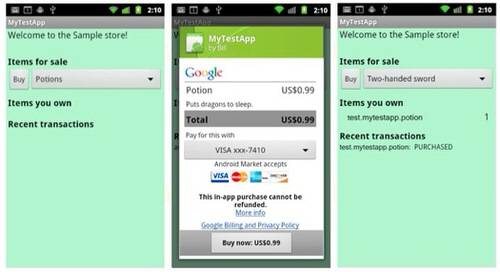Yesterday, Google launched its highly anticipated Android Market refresh, an update which now offers consumers the ability to browse and search for mobile applications from their desktop computer and then download those apps to their phone or tablet wirelessly. The experience is a vast improvement over the previous version of the Android Market, which oddly enough, didn’t even offer search functionality.

But while the front-facing features of the new Market got a lot of press, there were also two important changes for developers to take note of: added support for buyer’s currency and in-app purchases.
In-App Purchases
Google had been promising in-app billing support for some time, but finally made good on that yesterday, with the announcement that in-app billing has now arrived in the Android Market. This means that developers who want to monetize their apps using a different paradigm than simply charging for the app itself now have the option to do so. The addition will give rise to a number of new business models for monetizing applications including in-app upgrades, virtual goods purchases, try then buy upgrades, subscriptions and more.

This is arguably the most important change out of all the announced improvements yesterday, since clearly a poor Web experience has done nothing to stifle Android’s explosive growth. What has been affecting Android’s true potential, however, is the lack of app sales – and that’s according to Android Platform Manager Eric Chu. At last week’s Social Apps Conference in San Francisco, he even admitted that Google was “unhappy” about the purchases of paid applications in its marketplace.
But in-app purchases have the potential to shake up the market. In fact, according to a recent report from billing and analytics firm Bango, in-app purchases will grow over 600% this year to account for nearly 30% of all mobile app payments.
In addition, a separate report from analytics firm Flurry noted that in-app purchases accounted for 80% of revenues generated by mobile developers with apps in the social networking and social gaming categories.
Prior to Google’s official support, mobile payments companies like Zong and Boku have been offering similar solutions for developers who couldn’t wait for Google to roll out this much-needed monetization option. Those alternatives will still remain useful, especially for developers limited by Google’s version of in-app billing – it requires developers to have a Google Checkout merchant account and consumers to have the most recent version of the Android Market application and a device running Android 2.3 or higher. Also, it cannot be used for selling physical goods, personal services or anything that requires a physical delivery.
Google’s in-app billing support is not immediately available. Instead, the company will be rolling out updates to the Android Market client so developers can begin testing the new service. The goal is to have the service live for end users by the end of the quarter. Developers can read more about this option here or view the release information here.
Buyer’s Currency Changes
Another change in the Android Market’s billing options is the addition of Buyer’s Currency support. This means that developers can price their applications differently in different markets while also improving the end user experience by displaying prices in that person’s home currency.
As an end user, you may have noticed that paid applications are denoted with this symbol “~” – the punctuation mark meaning “approximately”. Due to currency conversions, this leads to odd prices, like ~$3.17 (the price for the popular launcher app ADW) or ~$2.06 (the price for the top paid widget app Beautiful Widgets). With Buyer’s Currency support, those developers could make the app’s price seem more attractive to shoppers by sticking to the retailing designations we’re comfortable with – for example, in the U.S., that would be prices that end in $.99.
This option will roll out to U.S. developers first, then other supported countries afterwards. Google says it expects the process to complete within fourth months.









